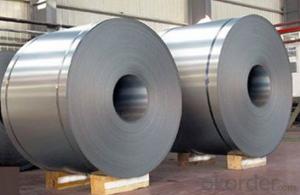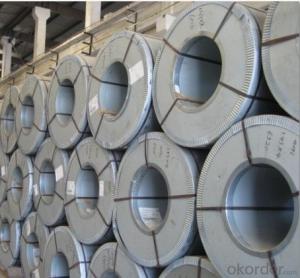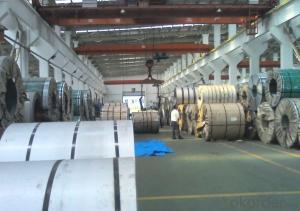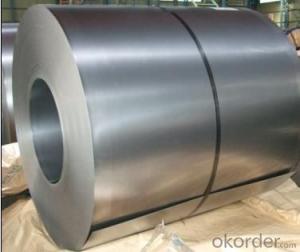Stainless Steel Coil 304 Hot/Cold Rolled 2B/NO.1
- Loading Port:
- Guangzhou
- Payment Terms:
- TT OR LC
- Min Order Qty:
- 100 m.t.
- Supply Capability:
- 20000 m.t./month
OKorder Service Pledge
OKorder Financial Service
You Might Also Like
Hot Rolled Stainless Steel Coil 304 Annealing and Pickling No.1 Finish
Stainless steel is a production which not easy rust,acid resistance and corrosion resistance,so it is widely
used in light industry,heavy industry,daily necessities and the decoration industry.
Hot Rolled Stainless Steel Coil 304 Specifications
1.surface:NO.1
2.standard:JIS, AISI, GB
3.width: 0.55m, 0.65m, 1.0m, 1.22m, 1.5m, 2m or requirement
Hot Rolled Stainless Steel Coil 304 Chemical Composition:
(%):C=0.07, Mn=2.00, P=0.045, S=0.030, Si=0.075, Cr=17.5-19.5, Ni=8.0-10.5, N=0.10
Hot Rolled Stainless Steel Coil 304 Physical Properties
Tensile strength σb (MPa) ≥ 520
the conditions yield strength σ0.2 (MPa) ≥ 205,
elongation δ5 (%) ≥ 40
Reduction of ψ (%) ≥ 50,
hardness: ≤ 187
HB; ≤ 90
HRB; ≤ 200H
- Q:How do stainless steel strips perform in high-pressure environments?
- Stainless steel strips have gained a reputation for their exceptional performance in high-pressure settings. They find widespread use in industries like oil and gas, chemical processing, and power generation, where they encounter extreme pressures and temperatures. One of the main advantages of stainless steel strips lies in their robustness and resistance to deformation. They possess the ability to endure intense pressure without distorting or compromising their structural integrity, making them an ideal choice for applications that demand reliability and durability. Furthermore, stainless steel strips exhibit excellent resistance to corrosion, particularly when alloyed with elements like chromium and nickel. This shields them from the detrimental effects of corrosive substances encountered in high-pressure environments, such as acids or salts. Their resistance to corrosion ensures that the strips retain their performance and structural strength over time. Another notable characteristic of stainless steel strips is their capacity to withstand high temperatures. They boast a high melting point and can endure extreme heat without deforming or weakening, making them suitable for applications involving elevated temperatures, such as heat exchangers or boilers. Additionally, stainless steel strips offer exceptional fatigue resistance, enabling them to withstand repeated cycles of pressure fluctuations without cracking or failing. This is especially crucial in high-pressure environments where the material is subjected to constant stress and strain. In conclusion, stainless steel strips are highly dependable and excel in high-pressure environments. Their strength, corrosion resistance, heat resistance, and fatigue resistance render them a preferred choice for various industries that prioritize reliability and performance.
- Q:What are the recommended packaging methods for 111 stainless steel strips?
- Different customers or manufacturers may have varying requirements and preferences for packaging 111 stainless steel strips. However, there are several commonly suggested packaging methods for stainless steel strips: 1. Wooden Crates: To ensure stability and protection during transportation, stainless steel strips can be placed in wooden crates. These crates often have foam or other cushioning materials inside to prevent scratching or damage to the strips. 2. Cardboard Boxes: If the quantity is small or the distance is short, stainless steel strips can be packed in sturdy cardboard boxes. These boxes should be strong enough to handle the weight and size of the strips and may be lined with plastic or paper to guard against moisture. 3. Plastic Wrapping: For storage or bulk transportation, stainless steel strips can be individually wrapped in plastic or shrink-wrapped. This creates a barrier against moisture, dust, and other contaminants. 4. Metal Banding: To secure and bundle the stainless steel strips, metal banding or strapping can be used. This method ensures that the strips remain tightly packed together during transit, reducing the risk of damage or shifting. 5. Vacuum Sealing: In specific situations, stainless steel strips may require airtight packaging to protect against corrosion or oxidation. Vacuum sealing the strips in moisture-resistant bags or pouches can establish a protective barrier and extend the product's shelf life. It's important to consider the specific storage or transportation conditions, such as temperature, humidity, and duration, when determining the recommended packaging method. It is advisable to consult the manufacturer or supplier for their specific recommendations based on the characteristics of the stainless steel strips and their intended use.
- Q:Can stainless steel strips be used in the food processing industry?
- Yes, stainless steel strips can be used in the food processing industry. Stainless steel is highly resistant to corrosion, easy to clean, and does not react with food or alter its taste. This makes it an ideal material for equipment, machinery, and tools used in food processing, ensuring hygienic and safe production processes.
- Q:Are 111 stainless steel strips resistant to pitting and crevice corrosion?
- 111 stainless steel strips exhibit resistance to pitting and crevice corrosion. With its high chromium content, stainless steel grade 111, or AISI 111, offers exceptional corrosion resistance. Furthermore, the inclusion of molybdenum further boosts its ability to withstand pitting and crevice corrosion, making it a suitable option for applications where such corrosion is a concern. Consequently, when corrosion resistance is necessary, 111 stainless steel strips prove to be a dependable selection.
- Q:Are stainless steel strips available in different widths?
- Yes, stainless steel strips are available in different widths.
- Q:Can stainless steel strips be used in chemical pumps?
- Yes, stainless steel strips can be used in chemical pumps. Stainless steel is highly resistant to corrosion and can withstand a wide range of chemicals, making it a suitable material for use in chemical pumps.
- Q:Can stainless steel strips be used in conveyor systems?
- Yes, stainless steel strips can be used in conveyor systems. Stainless steel is a durable and corrosion-resistant material that is well-suited for use in conveyor systems. It can handle heavy loads and withstand high temperatures, making it ideal for industrial applications. Stainless steel strips are commonly used in the construction of conveyor belts, as they provide strength and stability while allowing for smooth movement of materials. Additionally, stainless steel is easy to clean and maintain, ensuring the longevity and efficiency of the conveyor system.
- Q:Are stainless steel strips suitable for elevator interiors?
- Yes, stainless steel strips are suitable for elevator interiors. Stainless steel is a durable and hygienic material that is resistant to corrosion, making it ideal for high-traffic areas like elevators. Additionally, stainless steel strips can also enhance the aesthetic appeal of the elevator interiors, providing a sleek and modern look.
- Q:How does the thermal conductivity of 111 stainless steel strips compare to other materials?
- Compared to other materials, the thermal conductivity of 111 stainless steel strips is generally lower. When compared to metals like copper or aluminum, stainless steel is not an efficient conductor of heat. However, among the stainless steel family, the 111 grade may exhibit slightly higher thermal conductivity than other grades. Nevertheless, it remains lower than many commonly used materials. For applications that demand high thermal conductivity, materials like copper or aluminum, which possess superior thermal conductivity properties, would be more appropriate.
- Q:Are 111 stainless steel strips suitable for heat exchangers?
- Yes, 111 stainless steel strips are suitable for heat exchangers. They possess excellent corrosion resistance, high thermal conductivity, and good strength, making them ideal for heat transfer applications in heat exchangers.
1. Manufacturer Overview |
|
|---|---|
| Location | |
| Year Established | |
| Annual Output Value | |
| Main Markets | |
| Company Certifications | |
2. Manufacturer Certificates |
|
|---|---|
| a) Certification Name | |
| Range | |
| Reference | |
| Validity Period | |
3. Manufacturer Capability |
|
|---|---|
| a)Trade Capacity | |
| Nearest Port | |
| Export Percentage | |
| No.of Employees in Trade Department | |
| Language Spoken: | |
| b)Factory Information | |
| Factory Size: | |
| No. of Production Lines | |
| Contract Manufacturing | |
| Product Price Range | |
Send your message to us
Stainless Steel Coil 304 Hot/Cold Rolled 2B/NO.1
- Loading Port:
- Guangzhou
- Payment Terms:
- TT OR LC
- Min Order Qty:
- 100 m.t.
- Supply Capability:
- 20000 m.t./month
OKorder Service Pledge
OKorder Financial Service
Similar products
New products
Hot products
Related keywords































